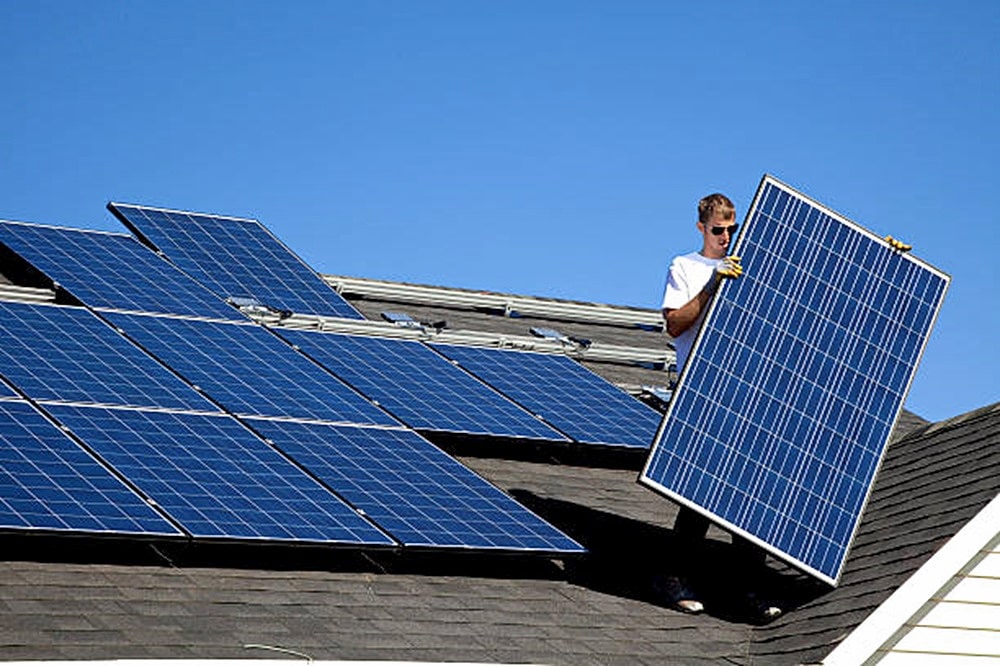As the sun rises over the Australian landscape, an increasing number of homeowners are looking towards the horizon and considering solar energy as a viable addition to their homes. The shift towards renewable energy sources is more than just a trend; it’s a reflection of a collective effort to reduce carbon footprints, save on energy costs, and invest in the sustainability of our planet. If you’re contemplating making the switch to solar, understanding the installation process is crucial. This guide aims to walk you through each step, ensuring you know exactly what to expect when going solar.
Why go solar?
Solar energy isn’t just about tapping into an endless supply of sunlight; it’s about harnessing this power in ways that offer significant benefits to homeowners and the environment alike.
- Cost savings: One of the most compelling reasons to go solar is the potential for substantial savings on electricity bills. Solar panels can generate free power for your home’s use, significantly reducing your reliance on the grid and, consequently, your monthly energy costs.
- Environmental impact: Solar power is clean, green, and renewable. By installing solar panels, you’re contributing to a reduction in greenhouse gas emissions, a crucial step in combatting climate change. It’s a way to ensure your household’s energy consumption is sustainable and responsible.
- Energy independence: Solar panels can provide a degree of energy independence, freeing you from the unpredictability of rising energy prices. With advancements in solar battery storage, you can store excess energy generated during the day for use at night, further reducing your reliance on the grid.
- Increased property value: Homes with solar installations often see an increase in property value. Prospective buyers value the energy efficiency and cost savings associated with solar-powered homes, making it a wise investment for the future.
Initial consultation and site assessment
The journey to harnessing the sun’s power begins with an initial consultation and a thorough site assessment. This crucial first step lays the groundwork for a successful solar installation, tailored to meet your home’s unique needs.
The consultation
It starts with a conversation with a solar energy provider. Be prepared to discuss your energy usage, goals for going solar, and any specific concerns you may have. This is the time to ask questions and get a clear understanding of what the solar installation process involves.
Site assessment
Following the consultation, a site assessment is conducted by a solar professional. This involves a detailed examination of your property, focusing on the roof’s condition, orientation, and any potential shading from trees or other structures. The goal is to determine the most efficient placement for your solar panels to maximise sunlight exposure and energy production.
The outcome of the site assessment will inform the design of your solar system, ensuring it’s perfectly suited to your home’s specifications and your energy needs. This personalised approach is key to optimising the performance of your solar panels.
Choosing your solar system
Selecting the right solar system is a pivotal decision that will affect your energy production and savings for years to come. It’s essential to consider several factors to ensure you choose a system that meets your needs and budget.
- System size: The size of the solar system you’ll need is determined by your typical energy usage and the amount of available space on your roof. It’s important to strike a balance between meeting your energy needs and making the most of your available roof space.
- Types of solar panels: Solar panels come in various types, including monocrystalline, polycrystalline, and thin-film. Each type has its advantages in terms of efficiency, cost, and appearance. Your choice will depend on your budget, aesthetic preferences, and how much roof space you have.
- Inverters: The inverter is a critical component that converts the DC electricity generated by your solar panels into AC electricity that can be used in your home. There are several types of inverters, including string inverters and microinverters, each with its benefits and considerations.
- Get multiple quotes: To ensure you’re getting the best deal and the right system for your needs, it’s advisable to obtain multiple quotes from different providers. You can start by using a service like Energy Matters’ FREE solar quotes to compare options and prices from trusted solar companies.
Choosing the right solar system involves careful consideration of your home’s energy needs, roof space, and budget. With the right information and advice, you can select a system that will provide maximum benefits and efficiency for your home.
As you navigate through the initial consultation, site assessment, and the selection of your solar system, remember that each step brings you closer to achieving energy independence and contributing to a more sustainable future.
Understanding solar rebates and incentives
One of the encouraging aspects of going solar in Australia is the availability of various solar rebates and incentives. These financial supports can significantly reduce the upfront cost of your solar panel installation, making solar energy more accessible and affordable.
- Federal solar incentive: Also known as the Small-scale Renewable Energy Scheme, this government incentive allows homeowners to receive certificates for their solar systems, which can be sold for a discount on the installation cost.
- State-specific incentives: In addition to federal rebates, some states offer additional incentives, such as feed-in tariffs for the surplus energy your solar system feeds back into the grid. It’s crucial to research what’s available in your state to maximise your benefits.
- Local council offers: Sometimes local councils also have initiatives or grants to encourage solar installations in their areas. Keep an eye out for these opportunities.
Understanding the rebates and incentives available to you can make a significant difference in your solar installation journey, reducing initial costs and enhancing long-term savings.
Finalising the design and quotation
Once you’re equipped with knowledge about solar rebates, incentives, and the types of solar systems available, finalising your solar installation’s design and getting a detailed quotation are crucial next steps. Your solar provider will use the insights gained from the site assessment alongside your energy needs to tailor a system design that maximises efficiency and aligns with your home’s unique characteristics. The resulting quotation will break down the costs involved, including the solar panels, inverter, and installation, while also factoring in any applicable rebates or incentives you’re eligible for. This comprehensive quotation not only lays out the initial investment required but also projects the energy production and potential savings, helping you make an informed decision on your solar energy journey.
Installation day
The day you’ve been waiting for has arrived – installation day. Here’s what to expect:
- Preparation: Ensure there’s clear access to your roof and any areas the installation team will need to work in. It’s also a good idea to secure pets and inform neighbours of potential noise.
- The installation process: A team of professional installers will arrive, ready to transform your roof into a powerhouse of solar energy. They’ll start by setting up the racking system, followed by the panels themselves, and finally, wiring the system to connect to your home’s electrical grid.
- Safety and quality checks: Throughout the installation process, safety measures are strictly adhered to. After the panels are installed, the team will conduct thorough quality checks to ensure everything is in perfect working order.
- Final walkthrough: Once installation is complete, you’ll be given a walkthrough of your new solar system, explaining how it works, how to monitor it, and any maintenance you’ll need to perform.
Installation day marks a significant milestone in your journey to solar energy. With professional installers at the helm, you can look forward to a smooth process and the start of your solar-powered life.
Grid connection and final inspection
After your solar panels are installed, the next crucial steps are connecting your system to the grid and passing the final inspection. These are essential to activating your solar system and ensuring it meets all safety and performance standards.
- Grid connection: This process involves coordinating with your local utility company to connect your new solar system to the electrical grid. This connection allows you to feed excess electricity back into the grid, often resulting in credits through feed-in tariffs. The time frame for this connection can vary, so it’s important to start this process early and be aware of your utility’s specific requirements.
- Final inspection: A final inspection by a certified electrician or inspector is typically required to ensure your solar installation complies with local building codes and electrical standards. This inspection is crucial for the safety and efficiency of your solar system. Once passed, you’ll receive an official approval or certification, signalling that your solar system is ready to go.
The grid connection and final inspection are pivotal to transitioning smoothly to solar energy, marking the final steps before you can fully harness the sun’s power.
Monitoring your solar system
Once your solar system is up and running, monitoring its performance is key to ensuring you’re getting the most out of your investment. Most modern solar systems come equipped with monitoring technology that allows you to track energy production, consumption, and overall system health in real time.
Why monitoring matters?
Keeping an eye on your solar system’s performance can help you identify any issues early, optimise your energy use, and maximise savings. For instance, you might notice patterns in your energy production that could lead you to adjust how and when you use certain appliances.
How to monitor
Solar monitoring systems typically provide access via a desktop dashboard or a mobile app, making it easy to check your system’s performance at any time. These tools can show you detailed graphs of daily, monthly, and annual energy production and usage, alerting you to any significant changes or potential problems.
For homeowners looking to ensure they’ve chosen a system that comes with robust monitoring capabilities, researching the “best solar panels in Australia” can provide insights into which systems offer superior performance and monitoring technology.
Monitoring your solar system is a straightforward but vital practice. It not only helps in maximising the efficiency and lifespan of your solar installation but also in optimising your household’s energy use for even greater savings over time.
Maintenance and warranty
Understanding the maintenance requirements and warranty details of your solar system is crucial to ensure its longevity and efficiency.
Maintenance
Solar panels are known for their durability and low maintenance needs. Regular checks include ensuring panels are clean and free from debris, which can affect performance. Most systems require a professional check-up every few years to inspect electrical connections and mounting hardware.
Warranty
Solar systems come with various warranties that cover panels, inverters, and workmanship. Panel warranties typically last between 10 to 25 years, guaranteeing a certain level of performance over time. Inverter warranties can range from 5 to 15 years. Additionally, installers may offer their own warranties on the quality of the installation work, which can provide peace of mind.
Staying informed about your system’s maintenance schedule and keeping warranty documents safe and accessible will help you manage your solar system effectively, ensuring it provides maximum energy output and savings.
Conclusion
Going solar is a significant but rewarding decision for Australian homeowners. The process, from initial consultation to monitoring your system’s performance, involves several crucial steps. Each phase requires careful consideration and planning, but the outcome offers substantial benefits, including reduced energy bills, increased property value, and a lower carbon footprint. With the right preparation and understanding of what to expect, the transition to solar energy can be a smooth and highly beneficial journey.
FAQ
How often do solar panels need to be cleaned?
Typically, solar panels require cleaning once or twice a year. However, this can vary based on your location and the level of dust or debris they’re exposed to.
What should I do if my solar system isn’t producing as much energy as expected?
First, check your monitoring system for any alerts or issues. If everything seems normal, contact your installer or a professional solar technician for a system check-up.
Can I add more panels to my existing solar system?
Yes, in many cases, you can expand your solar system. It’s best to consult with a solar professional who can assess your current setup and advise on the possibility of adding more panels.
Does shading affect solar panel performance?
Yes, shading can significantly impact the amount of energy your panels produce. It’s important to install panels in areas with minimal shading and manage any vegetation that may grow and cause shading over time.
What happens to my solar system during a blackout?
Most grid-connected solar systems will automatically shut off during a blackout for safety reasons. However, if your system includes a battery storage system, you may still be able to use stored solar energy.












































